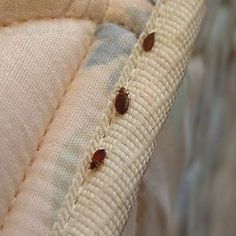Exploring the Science Behind Bed Insect Heat Treatments as a Sustainable Bug Administration Method
In the realm of bug monitoring, the mission for sustainable and efficient solutions stays a consistent pursuit. One such method that has actually gotten grip recently is using warmth treatments to combat bed insect invasions. By harnessing the scientific research behind thermal fatality factors for these relentless bugs, warm treatments provide an encouraging choice to standard chemical-based techniques. The complexities of how heat efficiently removes bed insects and the more comprehensive implications for sustainable parasite management methods make this a topic worth exploring further.
Bed Insect Warm Therapy Refine

Thermal Fatality Factor for Bed Insects
Subjecting bed insects to raised temperatures past their thermal tolerance range is crucial for achieving efficient obliteration in warm therapy procedures. The thermal death factor for bed pests describes the temperature level at which these bugs can not survive. Research study suggests that bed insects start to perish when subjected to temperature levels over 113 ° F(45 ° C) for a continual period. As the temperature level enhances, so does the mortality rate of bed insects. At around 118 ° F(48 ° C ), bed insects start to die rapidly, with a death rate of nearly 99% within mins of direct exposure. This demonstrates the level of sensitivity of bed pests to heats and highlights the effectiveness of warmth treatments in getting rid of problems. By reaching and maintaining temperature levels over the thermal death factor for bed pests, bug monitoring experts can guarantee comprehensive removal of bed insect populaces, consisting of hard-to-reach locations where chemical therapies may be much less reliable. Understanding the thermal death factor for bed bugs is vital for applying successful warm treatment strategies and achieving sustainable insect monitoring end results.
Benefits of Warm Treatments
Having actually developed the critical thermal death point for bed pests, it is imperative to currently check out the significant advantages that heat treatments supply in effectively getting rid of these resistant insects. When contrasted to traditional chemical methods, heat therapies present numerous key advantages. One of the primary advantages is that warmth can pass through deep into crevices and splits where bed pests conceal, guaranteeing that also one of the most hard-to-reach areas are heated to lethal temperature levels. This thorough approach not only kills real-time pests yet also targets bed pest eggs, protecting against future invasions.
Additionally, warmth treatments are safe and environmentally pleasant, making them a lasting insect management strategy. Unlike chemical pesticides, warmth treatments do not leave harmful deposits that can pose threats to human health or the atmosphere. This element is specifically important in sensitive atmospheres such as healthcare facilities, schools, and suburbs where chemical use may not be preferable.
In addition, warmth therapies have a high success price in getting rid of bed pest infestations in a solitary treatment, decreasing the requirement for multiple sees and minimizing disturbance to owners. This efficiency not only saves money and time yet also gives peace of mind to those dealing with bed insect issues.
Efficiency of Heat Treatment

Warmth treatments have actually the added benefit of eliminating bed bug eggs, which are typically resistant to traditional chemical treatments. On the whole, the effectiveness of warmth therapies in removing bed bug infestations makes them a lasting and reputable pest monitoring strategy.
Sustainable Parasite Administration Perks
Executing lasting pest administration methods offers long-lasting benefits for both the setting and public health and wellness. By using approaches such as heat therapies for bug control, we can decrease the reliance on unsafe chemical pesticides that can have adverse results on ecosystems and human health - exterminator near me. Lasting bug monitoring methods help in protecting biodiversity by targeting particular insects without harming non-target organisms, therefore maintaining a well balanced environment
In addition, lasting parasite monitoring methods add to the overall health and wellness and health of the general public. By lessening direct exposure to harmful chemicals made use of in conventional insect control techniques, warm treatments provide a more secure choice for parasite monitoring in residential, industrial, and public spaces. This reduction in chemical usage also aids in stopping chemical deposits from polluting dirt, air, and water, securing ecological top quality.
Conclusion
Finally, bed insect heat therapies have actually been revealed to be a sustainable and efficient parasite management technique. The thermal death point for bed insects makes them susceptible to warmth therapies, which have many advantages over traditional chemical treatments. The performance of warm therapies in removing bed bug problems while reducing ecological effect highlights the potential of this technique as a sustainable remedy for pest control.
The bed insect heat therapy process involves elevating the temperature level within plagued find out areas to a degree that successfully eliminates bed pests and their eggs. By reaching and keeping temperature levels over the thermal death point for bed pests, bug administration specialists can make certain extensive elimination of bed bug populaces, including hard-to-reach areas where chemical therapies may be less efficient. One of the primary advantages is that warmth imp source can permeate deep right into holes and fractures where bed insects conceal, making certain that also the most hard-to-reach areas are heated up to deadly temperatures. Unlike chemical treatments that might leave behind resistant populations, heat therapies provide a safe and ecologically friendly solution that can penetrate deep right into furniture, walls, and various other hard-to-reach areas where bed insects hide.
The thermal fatality factor for bed pests makes them at risk to warm therapies, which have countless benefits over standard chemical treatments.